This article was medically reviewed by Jennifer Boidy, RN. Jennifer Boidy is a Registered Nurse in Maryland. She received her Associate of Science in Nursing from Carroll Community College in 2012.
There are 13 references cited in this article, which can be found at the bottom of the page.
This article has been viewed 180,978 times.
Rectal thermometer usage is usually limited to taking a baby's temperature, but this method also may be used on aging adults who are ill. Doctors say that taking rectal temperature is the most accurate, especially for children under the age of four or anyone else who cannot cooperate in the taking of an oral temperature. Care must be practiced when taking someone's temperature rectally. The rectal wall may be pierced or other pain may be caused by incorrect usage methods. Here are some suggestions about how to safely and effectively use a rectal thermometer to take someone's temperature.
Steps
Knowing When You Need To Take A Rectal Temperature
-
1Look for symptoms of a fever. Keep in mind that young children and infants may not exhibit these symptoms. Fever symptoms include:[1]
- Sweating and shivering
- Headache
- Muscle aches
- Loss of appetite
- General weakness
- Hallucinations, confusion, irritability, convulsions, and dehydration may be present with high fevers.
-
2Consider the age, health condition, and behavior of the child or elderly person. For babies younger than 3 months, taking the temperature rectally is most recommended. This is because their ear canals are too small to use an electronic ear thermometer in them.[2]
- For kids between three months and four years, you can use either an electronic ear thermometer to take the temperature in the ear canal, or use a rectal thermometer to take the temperature rectally. You can also use any digital thermometer to take an underarm (axillary) temperature, though this is less accurate.
- For kids older than age 4 who are able to cooperate, you can use a digital thermometer to take the temperature orally. You will need to consider, however, if they must breathe through their mouths due to stuffy noses, because this can cause an inaccurate temperature reading. If this is the case, then you can also use an electronic ear thermometer, temporal artery thermometer, or use the digital thermometer to get an underarm (axillary) temperature.
- Similarly, for elderly adults, you’ll need to consider any uncooperative behavior or medical conditions that could interfere with obtaining a temperature reading to determine which method you should use.[3] If getting a rectal or oral temperature reading is impractical, then the tympanic method (using an electronic ear thermometer) or temporal method may be used.
Preparing To Use A Rectal Thermometer
-
1Purchase a digital rectal thermometer. These types of thermometers are available at pharmacies. Make sure that the digital thermometer you buy is labeled for rectal use. If you plan to use a digital thermometer for both oral and rectal temperatures, then buy two and label them accordingly. Also, never use a mercury thermometer, which is the glass kind that used to be used.[4]
- Rectal thermometers have a security bulb specifically designed for safely taking rectal temperatures.
- Review usage of your specific thermometer. Familiarization of the thermometer will aid in preventing prolonged insertion into rectum. Follow and keep the manufacturer's instructions for correct use to ensure safety and accuracy.
-
2Be sure that the baby or patient has not had a bath or been swaddled (when babies are wrapped tightly for warmth) in the past 20 minutes. This can cause an inaccurate reading.[5]
-
3Clean the tip of the rectal thermometer with soapy water or rubbing alcohol. Never use the same thermometer that you use in the rectum to take temperatures in other ways, because this can spread bacteria.[6]
-
4Apply petroleum jelly to the tip of the thermometer to make it easier to insert. If you prefer to use a disposable thermometer sleeve, use one of these instead and always dispose of after use and use a new one each time. But, be careful with the sleeves. They may pull off the thermometer as you are taking the temperature. You will need to hold it as you pull the thermometer out when you’re finished.[7]
-
5Lay your baby on his back and insert the digital thermometer into the rectum. Only insert it about ½ to 1 inch and do not force it in if there is resistance. Keep the thermometer in the baby’s rectum until it indicates that it is finished. Then, remove the thermometer and check the reading.[8]
- Turn the thermometer on.
Taking A Temperature Rectally
-
1Use one hand to gently separate the buttocks with the thumb and forefinger, so you can see the rectum. With your other hand, carefully insert the thermometer into the rectum, only one-half to one inch.[9] 1⁄2 to 1 inch (1.3 to 2.5 cm).
- The thermometer should be pointed toward the person’s belly button.
- Stop if you feel any resistance.
-
2Hold the thermometer in place with one hand on the buttocks. Use the other hand to comfort the patient and prevent them from moving around. It is important the patient remain still while the thermometer is inserted so they don't get hurt during the procedure.
- If the patient moves around too much, it may cause an inaccurate reading or injury to the rectum.
- Never leave a baby or an older patient unattended with a thermometer inside the rectum.
-
3Remove the thermometer carefully when the thermometer beeps or signals. Read the temperature and record it. Temperatures taken rectally generally read as 0.5 - 1 degree F (0.3-0.6 C) higher than temperatures taken orally.[10]
- As you remove the thermometer, be sure the disposable sleeve is removed from the patient's rectum, if you used one on the thermometer.
-
4Clean the thermometer thoroughly before storing it. Use soapy water or apply rubbing alcohol to the thermometer. Dry it and store it in its packaging so it is ready to use next time, and make sure to mark it for rectal use only.[11]
Seeking Medical Attention
-
1Call the doctor of a baby under 3 months old immediately if the rectal temperature is 100.4 °F (38 °C) or higher, even if there is no other sign of illness. This is very important. Young babies have limited ability to fight illness because their immune system isn’t fully developed. They are more prone to some serious bacterial infections such as kidney and blood stream infections, and pneumonia.[12]
- If the baby has a fever on the weekend or evening after office hours, go to the emergency room.
-
2Call the doctor for a high temp with or without other symptoms. Contact the doctor of a 3-6 month old baby with a temperature up to 102 degrees F (38.9C) and who seems unusually lethargic, irritable, or uncomfortable, OR call a doctor if the temperature is over 102F (38.9C) with or without any symptoms.[13]
- For a child 6 to 24 months, call a doctor if the baby’s temperature is over 102F (38.9C) and lasts more than one day with no symptoms. If the child has symptoms such as cough, diarrhea, cold, you may want to consider calling sooner depending on the severity of the symptoms.
-
3Watch for other situations when you need to contact a doctor. There are certain other situations when you may need to contact a doctor. This will depend on the age of the person and the symptoms they are having.
- For a child over age 2, call a doctor for a fever up to 102F (38.9C) with vague symptoms (lethargy, restlessness, seems uncomfortable. Also, call a doctor for a temperature over 102F that lasts longer than 3 days and is not responding to medication.[14]
- For adults, contact a doctor for a fever that is not responding to medication, is 103F (39.4C) or over, or that lasts over 3 days.[15]
-
4Watch for a lower than normal temperature in a newborn. If a newborn has a lower than normal temperature, which would be lower than 97F (36.1C), then you should call your doctor right away. Young infants may not regulate their temperature well when ill.[16]
-
5Contact the doctor of a person of ages 2 and up who has any fever without any other illness symptoms (cold symptoms, diarrhea, etc.) for 3 days, or is accompanied by the following conditions:[17]
- a sore throat for more than 24 hours
- shows signs of dehydration (dry mouth, less than one wet diaper in 8 hours or urinating less frequently)
- pain when urinating
- refuses to eat, has a rash, or has difficulty breathing, or
- has recently returned from a trip in another country.
-
6Seek emergency medical attention for a child in certain situations. In some situations, you may need to seek emergency medical attention for a child with a fever. If a child develops a fever after being left in a hot car or another potentially dangerous situation, seek emergency medical attention if you notice that the child has:[18]
- A fever and is not sweating.
- A severe headache
- Confusion
- Ongoing vomiting or diarrhea
- Seizures
- A stiff neck
- Irritability or noticeable discomfort
- Any other unusual symptoms.
-
7Seek emergency medical attention for an adult if certain symptoms are present. Adults may also require emergency medical attention in some situations. Seek emergency medical attention for an adult if they have a fever and you also notice:[19]
- They are complaining about a severe headache.
- They have severe throat swelling.
- An unusual skin rash, especially one that becomes worse quickly.
- They complain about a stiff neck and have pain when they bend their head forward.
- They are unusually sensitive to bright lights.
- They seem confused.
- They are coughing persistently.
- They are complaining about muscle weakness or sensory changes.
- They have a seizure.
- They seem to be having trouble breathing or complain of chest pain.
- They seem extremely irritable or listless.
- They have abdominal pain when they urinate.
- You notice any other unexplained symptoms.
Warnings
- Taking rectal temperatures can cause internal injury. In general, bleeding from rectum, hemorrhoids, and recent lower intestinal surgery would place the person at higher risk for further injury.⧼thumbs_response⧽
References
- ↑ https://my.clevelandclinic.org/health/symptoms/10880-fever
- ↑ https://www.kidshealth.org/en/parents/fever.html?view=ptr
- ↑ http://cid.oxfordjournals.org/content/31/1/148.full
- ↑ https://www.hopkinsmedicine.org/health/conditions-and-diseases/measuring-a-babys-temperature
- ↑ https://www.babycenter.com/health/illness-and-infection/how-to-take-your-babys-temperature_11508
- ↑ https://www.drugs.com/cg/taking-a-rectal-temperature-aftercare-instructions.html
- ↑ https://my.clevelandclinic.org/health/articles/9959-thermometers-how-to-take-your-temperature
- ↑ https://www.hopkinsmedicine.org/health/conditions-and-diseases/measuring-a-babys-temperature
- ↑ https://myhealth.alberta.ca/Health/pages/conditions.aspx?hwid=zm6312
- ↑ https://myhealth.alberta.ca/Health/pages/conditions.aspx?hwid=zm6312
- ↑ https://myhealth.alberta.ca/Health/pages/conditions.aspx?hwid=zm6312
- ↑ https://myhealth.alberta.ca/Health/pages/conditions.aspx?hwid=zm6312
- ↑ https://raisingchildren.net.au/babies/health-daily-care/health-concerns/fever#when-to-see-your-doctor-about-fever-and-high-temperature-nav-title
- ↑ https://kidshealth.org/en/parents/fever.html
- ↑ https://my.clevelandclinic.org/health/symptoms/10880-fever
- ↑ https://www.nhs.uk/conditions/baby/health/is-your-baby-or-toddler-seriously-ill/
- ↑ https://medlineplus.gov/ency/patientinstructions/000319.htm
- ↑ https://kidshealth.org/en/parents/fever.html
- ↑ https://medlineplus.gov/ency/article/003090.htm
About This Article
To use a rectal thermometer, first apply petroleum jelly to the tip to make it easier to insert. Then, lay the baby or patient on their back and spread their buttocks with your thumb and forefinger so you can see their rectum. While holding their buttocks open, use your other hand to gently insert the thermometer half an inch to an inch inside. When the thermometer beeps or signals that it’s finished, carefully remove it and note down the reading. Make sure to clean the thermometer thoroughly with soapy water or rubbing alcohol before storing it. For more tips from our Medical co-author, including how to identify a fever, read on!




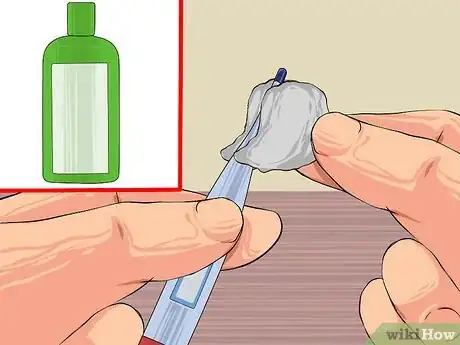
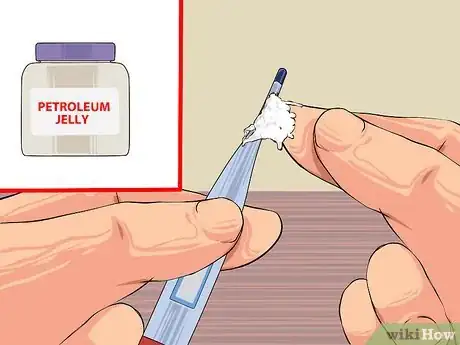



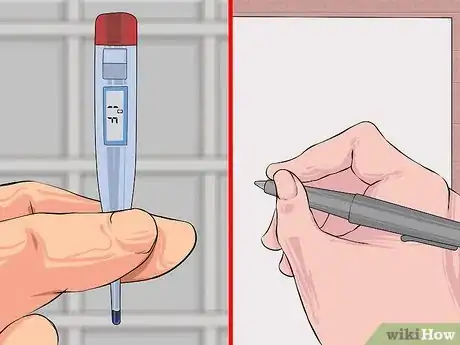
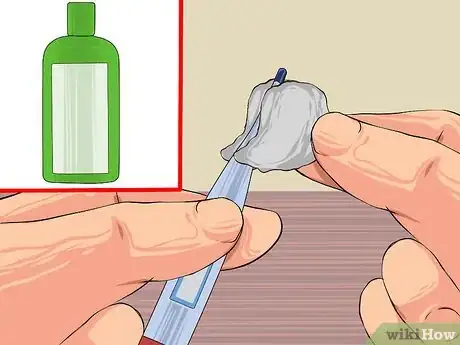


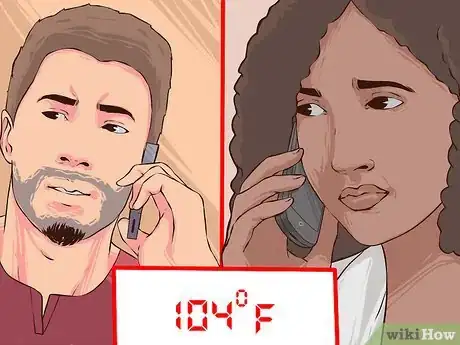









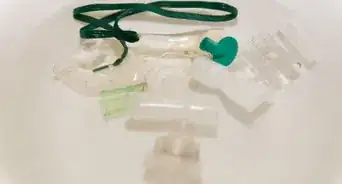
















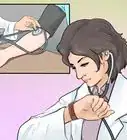



































Medical Disclaimer
The content of this article is not intended to be a substitute for professional medical advice, examination, diagnosis, or treatment. You should always contact your doctor or other qualified healthcare professional before starting, changing, or stopping any kind of health treatment.
Read More...